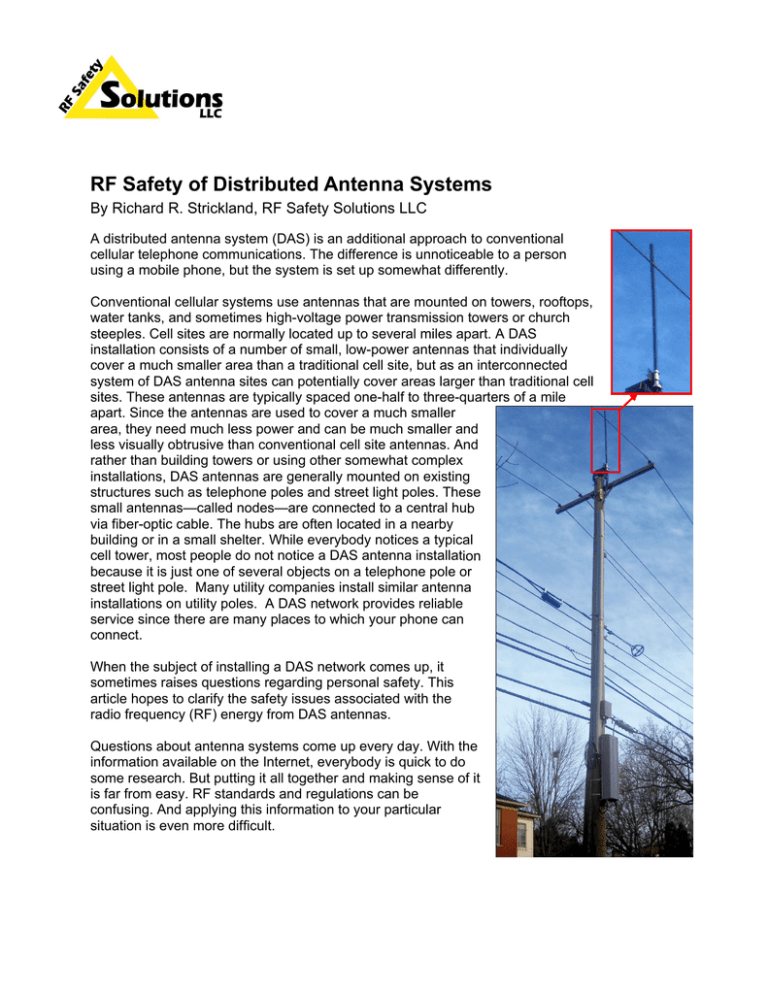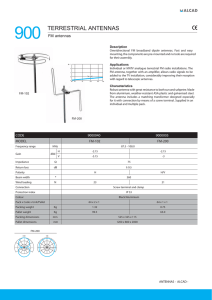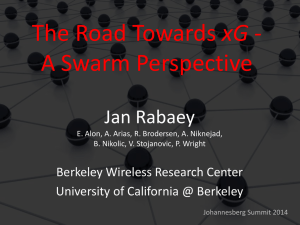RF Safety of DAS Antennas
advertisement

RF Safety of Distributed Antenna Systems By Richard R. Strickland, RF Safety Solutions LLC A distributed antenna system (DAS) is an additional approach to conventional cellular telephone communications. The difference is unnoticeable to a person using a mobile phone, but the system is set up somewhat differently. Conventional cellular systems use antennas that are mounted on towers, rooftops, water tanks, and sometimes high-voltage power transmission towers or church steeples. Cell sites are normally located up to several miles apart. A DAS installation consists of a number of small, low-power antennas that individually cover a much smaller area than a traditional cell site, but as an interconnected system of DAS antenna sites can potentially cover areas larger than traditional cell sites. These antennas are typically spaced one-half to three-quarters of a mile apart. Since the antennas are used to cover a much smaller area, they need much less power and can be much smaller and less visually obtrusive than conventional cell site antennas. And rather than building towers or using other somewhat complex installations, DAS antennas are generally mounted on existing structures such as telephone poles and street light poles. These small antennas—called nodes—are connected to a central hub via fiber-optic cable. The hubs are often located in a nearby building or in a small shelter. While everybody notices a typical cell tower, most people do not notice a DAS antenna installation because it is just one of several objects on a telephone pole or street light pole. Many utility companies install similar antenna installations on utility poles. A DAS network provides reliable service since there are many places to which your phone can connect. When the subject of installing a DAS network comes up, it sometimes raises questions regarding personal safety. This article hopes to clarify the safety issues associated with the radio frequency (RF) energy from DAS antennas. Questions about antenna systems come up every day. With the information available on the Internet, everybody is quick to do some research. But putting it all together and making sense of it is far from easy. RF standards and regulations can be confusing. And applying this information to your particular situation is even more difficult. RF Safety Issues with Wireless System Antennas The major concern over exposure to RF energy is heating of the human body. Workers who climb wireless towers and get very close to wireless services antennas must take care not to be exposed to excessive levels of RF energy, which is the reason that most companies require that workers who climb towers complete RF safety training. This is where I come in. Wireless antennas have extremely little energy directed downward—doing so would simply be a waste of energy. The RF energy level anywhere on the ground in the vicinity of a DAS antenna is far less than one percent of the levels allowed by the Federal Communications Commission (FCC) for public exposure. For people at a similar elevation as a DAS antenna, such as the top floor of a home, there is also nothing to worry about because, once the energy is just a few feet from the antenna, it begins to spread out in two dimensions, so the energy level drops off dramatically with distance. The energy level 30 feet from an antenna is only 1 percent of the energy level 3 feet from the antenna. And the energy level just 3 feet in front of a DAS antenna is well below the FCC limit for public exposure! At a distance of 30 feet directly in line with a DAS antenna RF exposure potential is less than for a person using a cordless phone. DAS antennas are mounted a little closer to the ground than a typical tower-mounted wireless service antenna. But since they operate at only a fraction of the power level, the RF energy level at ground level is even lower than it is with traditional tower-mounted antennas. The energy from DAS and traditional cellular antenna systems spreads out and rapidly diminishes in intensity as the distance from the source increases. RF energy spreads out just like light—both are forms of non-ionizing radiation (see sidebar). In both cases, the source can give off energy in all directions or it can be focused to some degree. A simple light bulb gives off light in all directions while a flashlight concentrates the energy in one direction. A typical DAS antenna operates at a power level of just 14 Watts. That is the equivalent of two night-light bulbs! Using the analogy of the two 7-Watt light bulbs, consider how bright the light would be at ground level if you substituted those light bulbs for the antenna on the top of the telephone pole shown on the first page. RF Energy and the Human Body Much of the confusion and concern over exposure to RF energy comes from confusion over the two forms of radiation that people might encounter. I hear it in the classes that I teach and make a point to explain the difference in every class, even if the students are all professional engineers. Say the word “radiation” and everybody gets concerned. Radioactive materials and X-rays generate what is known as ionizing radiation, which can be very dangerous. Ionizing radiation kills or mutates human cells, its effects are cumulative, and there is no practical minimum. So, continuous exposure to low levels of ionizing radiation can eventually lead to serious health problems. Just getting an X-ray kills or mutates millions of cells in your body. But your body will repair itself within two weeks, provided there is no additional exposure. However, the person giving you the X-ray has to be very careful to get behind the lead in the door so that they don’t get exposed. Unlike you, their exposure could be repetitive and cause cumulative effects. In contrast, radio frequency energy and the energy from most of the light frequencies are forms of non-ionizing radiation. This form of energy can heat tissue when it is concentrated enough and is the principle behind the common microwave oven and lasers. But exposure to very tiny amounts of RF energy has much less impact on you than if the temperature in the room you are in were to change by a small fraction of a degree. Problems occur with exposure to RF energy only when it is so concentrated that your body has a problem dealing with the excess heat. The effects are very similar to overexertion. RF Effects from Wireless Phones versus DAS Antennas People who do some reading on the subject come across concerns about exposure to wireless energy, and the tendency is to equate this as a concern over the antennas on the tower. The reality is that if there is any RF safety concern related to wireless phone systems, it is with using the phone itself, not with the energy from the antennas on the tower. The only exception is if you are a worker on the tower very close to one or more of the antennas. Here are two statements that apply to every tower or DAS site with wireless antennas: 1. If you hold a wireless phone near your head, as opposed to texting or using a headset or other hands-free device, you will absorb an absolute minimum of 100 times more RF energy than the maximum you could absorb from any tower-mounted wireless or DAS antenna, assuming you are on the ground. 2. If wireless reception is poor in your area, the installation of DAS antennas will dramatically reduce the RF exposure of anyone who uses a wireless phone in a handheld mode. By adding the additional antennas, the cell phones in the area will dramatically reduce their operating power level. Cell phones are programmed to use the minimum amount of power needed to make a good connection. So, when the signal is strong (lots of bars), the phone transmits at no more than 10 percent of the power that it uses when the signal is weak. And when the connection is poor, people tend to hold the phone tightly to their heads so that they can hear better, which further increases their exposure by another factor of 10. So, a person holding a phone tight to his or her head with a poor connection will absorb at least 100 times more RF energy than when the phone is held about an inch away and the signal is strong. Under these worst-case conditions, the amount of RF energy absorbed will be a minimum of 25,000 times higher than you could possibly absorb from a DAS antenna mounted on a light pole or telephone pole. Evidence generally points to cellular phones being safe, but there is no doubt that the RF exposure that one gets from using a phone is much higher than one gets from DAS antennas, and that by having the antennas nearby, your phones will operate at reduced power levels. Qualifications and Background I have 40 years of experience in the electronics industry, a B.A. in Physics, and an M.B.A. The last 16 years have been focused entirely on radio frequency (RF) radiation safety. I began work as an independent consultant about 10 years ago, working in many different industries, as well as with the government and the military. I have never worked for any of the companies that operate wireless phone services, but I have worked with many of the smaller companies that build and maintain these systems. My work with these companies is primarily related to providing training for the personnel who climb the towers and work in close proximity to the wireless and other wireless services antennas such as those used for fire, police, and emergency services. Sometimes I am asked to independently evaluate the RF energy levels on sites such as building roofs or on the ground near towers. More information on my background and the subject of RF radiation safety is available at www.RFSafetySolutions.com.


![EEE 443 Antennas for Wireless Communications (3) [S]](http://s3.studylib.net/store/data/008888255_1-6e942a081653d05c33fa53deefb4441a-300x300.png)

